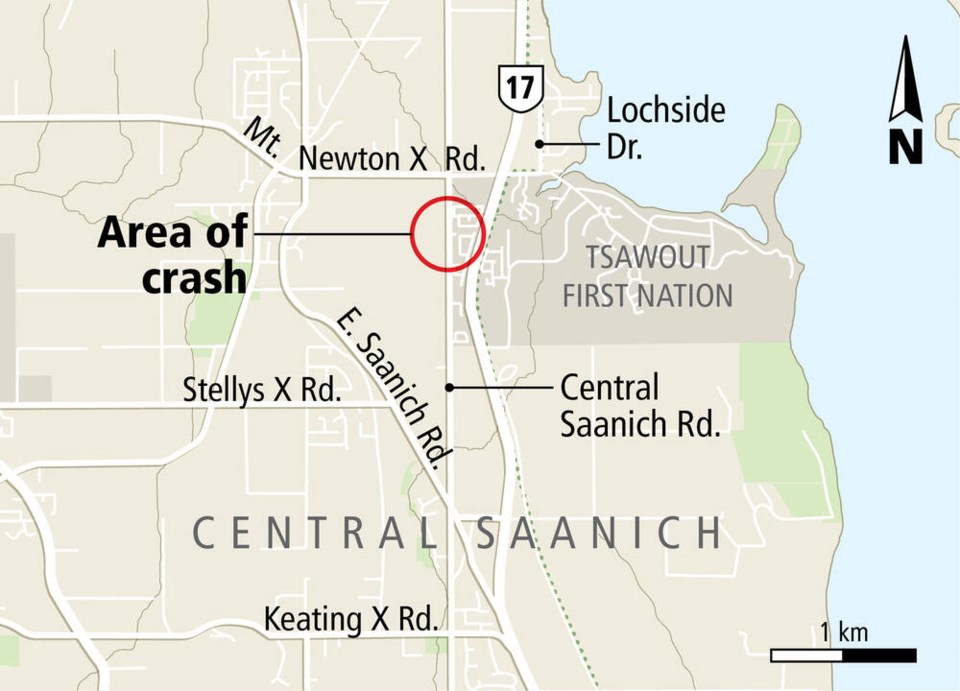A Central Saanich man suddenly and unexpectedly fell asleep from natural exhaustion when his vehicle struck and killed a Victoria woman and critically injured her sister, the defence argued in B.C. Supreme Court on Thursday.
Anthony Thomas has pleaded not guilty to six driving offences, including impaired driving and dangerous driving causing the death of Kim Ward on Aug. 27, 2018, and impaired driving and dangerous driving causing bodily harm to her sister, Tracy Ward.
Kim Ward, 51, a Victoria massage therapist who had worked with some of Canada’s top athletes at two Olympics, and her sister were visiting their mother. Tracy Ward has never recovered from her injuries.
The Crown has said Thomas fell asleep in the “crash phase” of a methamphetamine high when he was experiencing an overwhelming sense of fatigue. His red Jeep drifted over the centre line of Central Saanich Road, crossed the northbound lane onto the shoulder of the road and grass where the sisters were walking.
Defence lawyer Peter Blokmanis said the Crown had failed to establish that the fatal collision was caused by Thomas being impaired by methamphetamine and Alprazolam, a benzodiazepine.
Even if Thomas was impaired, the Crown did not prove the impairment made him fall asleep, said Blokmanis. In the U.S., methamphetamine is prescribed for medical purposes and is known to improve alertness and energy. Toxicologist Kimberly Young, an expert Crown witness, testified that methamphetamine may have a positive effect on driving ability, he noted.
It’s a reasonable possibility, consistent with all the evidence, that Thomas consumed methamphetamine to stay awake in a natural state of exhaustion and that he lost consciousness “not because of his methamphetamine consumption, but in spite of it,” said Blokmanis.
The Crown also believes that Thomas was in a minor fender-bender at Mount Newton Cross Road and Lochside Drive a few minutes before the fatal collision and should have known it was not safe for him to drive.
Blokmanis argued that the other driver, Michaela Pelton, who was 16 at the time, did not remember the exact time of the accident. During cross-examination, she agreed it could have been as early as 4:30 p.m. not a few minutes before 7 p.m. Pelton said the driver could have been anywhere from 25 to his late-40s.
Witness Jeff Underwood identified Thomas as the driver in the fender-bender, but said the other driver was a middle-aged woman with grey hair, said Blokmanis, urging the court not to accept “unreliable” evidence.
The defence lawyer also argued that a paramedic and two police officers at the scene did not suspect Thomas was impaired.
Const. Jessica Craig initially didn’t think Thomas was impaired. Later, at the hospital, she saw him bumping into walls. In cross-examination, she acknowledged the bumping was also consistent with the fact Thomas had been in a high-speed collision and was walking with a limp.
“The slight bumping into a wall did not even establish, in the mind of a trained police officer, who had been in the best position to observe it at close range, subjective grounds to suspect impairment,” said Blokmanis.
Although the level of methamphetamine in Thomas’s blood — 297 nanograms per millilitre — is within the common range for impaired drivers, it does not necessarily indicate impairment, said Blokmanis. Young’s toxicology report stated that the physical and behavioural effects of methamphetamine typically last four to eight hours after a single dose and levels in the blood are supposed to reduce by half every six to 15 hours. This means Thomas could have taken methamphetamine several days earlier. Alprazolam also lasts for a long time in the body which means Thomas could have taken it several days earlier.
“In the absence of any reliable method to calculate how and when Mr. Thomas consumed methamphetamine or Alprazolam, how much he consumed, whether and to what extent he had developed tolerance … the blood sample is incapable of proving impairment beyond a reasonable doubt,” Blokmanis concluded.
A date for Justice Brian MacKenzie’s decision will be scheduled on Feb. 23.



